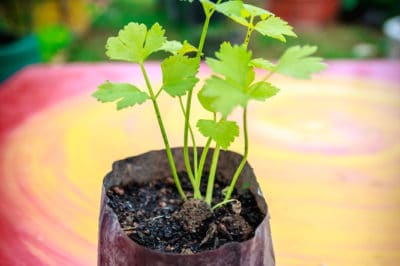Use Fresh Celery Seeds
One key to growing celery from seed is to use fresh seed. Although celery seed is supposed to be good for five years if properly stored, few home gardeners have ideal storage conditions. You’ll probably have better results if you stick to seed that is only one to two years old. If you do store your seeds, keep them cool and dry.
Celery Varieties
Growing your own means you can harvest unusual varieties that never make it to the grocery, such as:
- Tango Green – an apple green disease and heat resistant variety that is self-blanching.
- Red Venture – a hybrid with interior stems of red.
- Celebration – taller and heavy stalks of dark green.
- French Dinant – allows harvesting of individual stalks.
- Dorato – Italian variety with golden yellow stalks.
Soil Preparation
Celery is a heavy feeder and needs nutrient-rich soil. Amend your soil with plenty of well-rotted leaves, good compost or well-aged manure. In addition, work in organic 5-10-10 fertilizer before you transplant the seedlings. Use compost or manure tea to provide extra nutrients. Celery benefits from an additional feeding of fertilizer – about one tablespoon per plant – at least twice during the growing season.
Germinating Celery Seeds
Celery needs an early start because of its long growing season. Sow the seeds indoors about 10 to 12 weeks before the last frost of the spring. Try soaking them in chamomile tea overnight before sowing. Seeds should be just barely covered. Celery germinates best with soil temperatures between 70 to 75°F (21 to 24°C) and air temperatures of 60 to 70°F (16 to 21°C).
Spacing and Thinning
Celery seeds are very tiny, so it’s better to mix the seed with fine sand and sow a little too thickly. Once the seedlings are up, use a pair of fine-pointed scissors to cut out the extra plants to a spacing of three to four inches. Continue to grow until the plants are about four inches tall, then transplant to the garden on six to 10 inch spacing.
Managing Celery in the Garden
Never let celery go dry. A steady supply of moisture is important for best flavor and texture. Soaker hoses and drip irrigation are a good way to meet celery’s moisture needs. Keep the bed weeded, as celery doesn’t compete well with weeds. If necessary, spray with garlic and red pepper solution to control insect pests.
